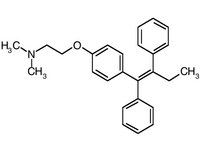Decisions regarding tamoxifen (Nolvadex) use in the prevention of breast cancer are complex. Investigators in the Breast Cancer Prevention Trial, a large nationwide study, found that tamoxifen prophylaxis reduced the risk of invasive breast cancer in women with moderate to high risk. However, this and other studies have not found an overall survival benefit or addressed quality-of-life issues. Because of uncertainty arising from the Breast Cancer Prevention Trial and other analyses, the U.S. Preventive Services Task Force advises against routine chemoprevention, but it suggests that the use of tamoxifen may be appropriate in women at high risk of breast cancer and low risk of adverse effects from tamoxifen. To help physicians make practical decisions about chemoprophylaxis, Cykert and colleagues conducted a cost-effectiveness analysis of tamoxifen chemoprophylaxis, including quality-of-life variables, and evaluated the advantages and disadvantages of therapy in high-risk women.
The authors interviewed a stratified sample of 106 women who were 50 years and younger. The women answered questions regarding various health scenarios, including curable breast and endometrial cancers, metastatic cancer with a two-year life expectancy, stroke resulting in mild to severe debility, pulmonary embolism, deep venous thrombosis, and hot flashes. The results were converted into health utility scores, which were incorporated into a statistical model. The outcomes were compared with data from the Breast Cancer Prevention Trial, in which the average patient was a 50-year-old woman on a five-year regimen of tamoxifen or placebo. Other data, such as probabilities of death in each of the scenarios, were obtained from the most recent age- and sex-specific estimates.
Quality of life was similar for women in both groups (placebo and tamoxifen) who had an intact uterus--approximately 26 quality-adjusted life-years (QALYs) remaining. The cost-effectiveness ratio was $43,300 per QALY. These estimates changed considerably with age. The incidence of endometrial cancer and clotting disorders in women 50 to 65 years of age increased the costs of tamoxifen prophylaxis while reducing the net benefits. For 60-year-old women, the cost-effectiveness ratio was $128,000 per QALY if the uterus was intact, and $63,000 in those who had undergone hysterectomy. After evaluating for sensitivity, the authors found that tamoxifen prophylaxis was favorable in women who were younger, who were without a uterus, who had high initial risk of breast cancer, and who had increased fear of curable breast cancer. Reductions in the cost of tamoxifen or increases in the cost of treating breast cancer would also make prophylaxis a more favorable option.
The authors conclude that a woman approximately 40 years of age with high risk factors for breast cancer (i.e., early menarche, first pregnancy late in life, history of breast biopsies) would benefit from tamoxifen chemoprophylaxis. Among women 50 years and older, those who have at least one first-degree relative with breast cancer or who have a personal history of atypical hyperplasia would benefit. A woman of any age with a history of high-risk ductal or lobular carcinoma also might benefit from tamoxifen. The role of tamoxifen prophylaxis in BRCA-positive women is unknown. The authors suggest that tamoxifen may be underused in selected groups of women who could benefit from prophylaxis. However, they caution against its general use as chemoprevention, particularly in women 60 years and older.
Cykert S, et al. Tamoxifen for breast cancer prevention: a framework for clinical decisions. Obstet Gynecol September 2004;104:433-42.
COPYRIGHT 2005 American Academy of Family Physicians
COPYRIGHT 2005 Gale Group



